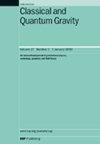克尔黑洞上的引力波:I. 重构线性化度量扰动
IF 3.6
3区 物理与天体物理
Q2 ASTRONOMY & ASTROPHYSICS
引用次数: 0
摘要
旋转克尔黑洞的引力扰动是出了名的复杂,即使在线性层面上也是如此。1973 年,特乌科尔斯基证明,它们的物理自由度被编码为两个轨距不变的韦尔曲率标量,它们服从一个可分离的波方程。确定这些标量足以满足许多目的,例如计算能量通量。然而,有些应用--如二阶扰动理论--需要重建度量扰动。从原理上讲,这个问题很早就解决了,但在实践中,却从未明确地解决过。在这里,我们通过写下与任一韦尔标量的给定模式相对应的度量扰动(入射或出射量规)来解决这个问题。我们的公式不涉及赫兹势(一个不发挥基本作用的中间量),只涉及径向和角向的克尔模式,而不涉及它们的导数,导数可以用 Teukolsky-Starobinsky 等式完全消除。我们希望这些分析结果能在数值研究和将黑洞扰动理论扩展到线性机制之外时证明是有用的。本文章由计算机程序翻译,如有差异,请以英文原文为准。
Gravitational waves on Kerr black holes: I. Reconstruction of linearized metric perturbations
The gravitational perturbations of a rotating Kerr black hole are notoriously complicated, even at the linear level. In 1973, Teukolsky showed that their physical degrees of freedom are encoded in two gauge-invariant Weyl curvature scalars that obey a separable wave equation. Determining these scalars is sufficient for many purposes, such as the computation of energy fluxes. However, some applications—such as second-order perturbation theory—require the reconstruction of metric perturbations. In principle, this problem was solved long ago, but in practice, the solution has never been worked out explicitly. Here, we do so by writing down the metric perturbation (in either ingoing or outgoing radiation gauge) that corresponds to a given mode of either Weyl scalar. Our formulas make no reference to the Hertz potential (an intermediate quantity that plays no fundamental role) and involve only the radial and angular Kerr modes, but not their derivatives, which can be altogether eliminated using the Teukolsky–Starobinsky identities. We expect these analytic results to prove useful in numerical studies and for extending black hole perturbation theory beyond the linear regime.
求助全文
通过发布文献求助,成功后即可免费获取论文全文。
去求助
来源期刊

Classical and Quantum Gravity
物理-天文与天体物理
CiteScore
7.00
自引率
8.60%
发文量
301
审稿时长
2-4 weeks
期刊介绍:
Classical and Quantum Gravity is an established journal for physicists, mathematicians and cosmologists in the fields of gravitation and the theory of spacetime. The journal is now the acknowledged world leader in classical relativity and all areas of quantum gravity.
 求助内容:
求助内容: 应助结果提醒方式:
应助结果提醒方式:


